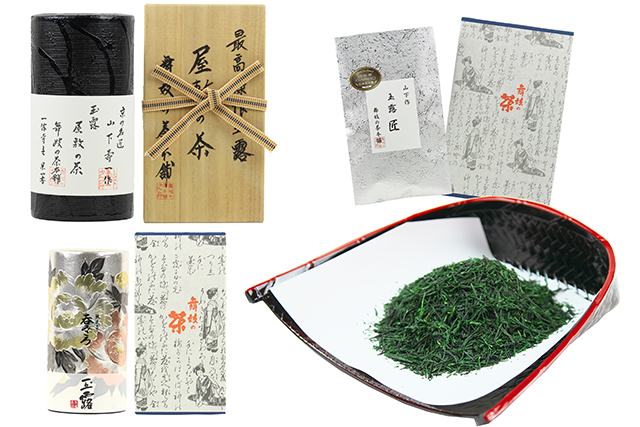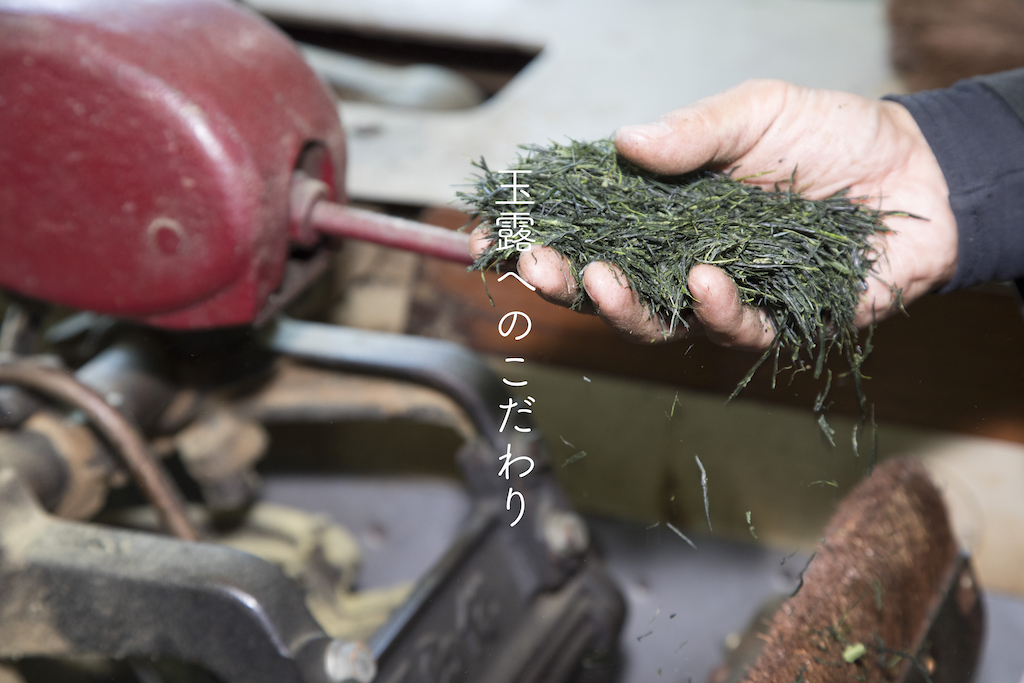

The tea fields that produce Gyokuro are called Ooishita-en. These gardens are partially shaded by tarps as new shoots begin to sprout in mid-April. Gyokuro and also tencha (used to make matcha) are produced from these fields. They are seen throughout Uji City and Kyotanabe City in Kyoto prefecture. However, throughout the country this type of field is rarely seen.
Protected from direct sunlight, tea produced from this type of field is less astringent, sweeter, and has increased mellowness.
◎ Protected from direct sunlight → weak astringency, mellow taste
Ooishita-en are commonly seen in Kyotanabe City where Maiko Tea is located. This area is especially famous for the production of Gyokuro tea.
手もみ製法
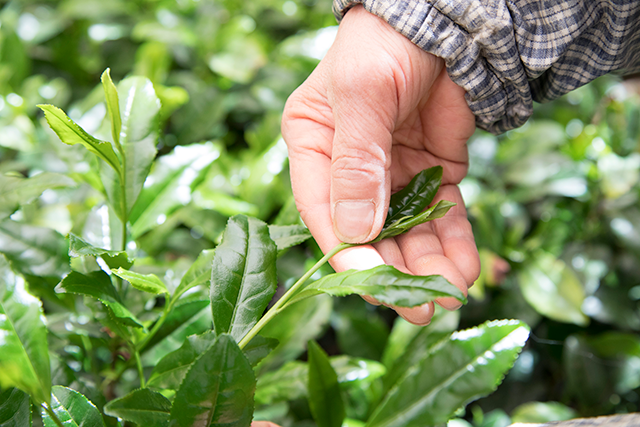
In Kyotanabe, a city esteemed for the highest quality of Gyokuro, the traditional method of hand-plucked tea has been practiced and preserved until today. One leaf is carefully selected at a time.
From one kilogram of freshly picked tea shoots, merely 150 g of Gyokuro is produced. Even the most experienced tea pickers can only harvest about 10 kg of fresh leaves in one day which calculates to approximately 1.5 kg of the final product.
Hand plucking tea is a truly time-consuming and costly tedious work. Therefore, only the finest quality teas are made from hand-plucked shoots
From one kilogram of freshly picked tea shoots, merely 150 g of Gyokuro is produced. Even the most experienced tea pickers can only harvest about 10 kg of fresh leaves in one day which calculates to approximately 1.5 kg of the final product.
Hand plucking tea is a truly time-consuming and costly tedious work. Therefore, only the finest quality teas are made from hand-plucked shoots
機械もみ

With the invention of the tea rolling dryer (soujuuki) in 1896, machinery began to replace the orthodox hand-kneading "temomi" method. Today, due to developing technology, there are automated factories processing tea completely by machine power.
It may be inevitable for machinery to replace manual labor. However, it is important to remember that the orthodox hand-processing method serves as the foundation for machine developments. In the column below, we introduce the Kyoto Gyokuro Research Center (Kyotanabe Gyokuro Seicha Gijutsu Kenshu Koujo) which exclusively produces Gyokuro tea. This research center relies partly on machines for processing tea. Although they may all look the same, each batch of tea leaves varies from others in many aspects such as moisture content. The length of time suitable in each step of processing differs for each batch. In factories where processing is completely done by machine power, these careful and exact adjustments cannot be made.
It may be inevitable for machinery to replace manual labor. However, it is important to remember that the orthodox hand-processing method serves as the foundation for machine developments. In the column below, we introduce the Kyoto Gyokuro Research Center (Kyotanabe Gyokuro Seicha Gijutsu Kenshu Koujo) which exclusively produces Gyokuro tea. This research center relies partly on machines for processing tea. Although they may all look the same, each batch of tea leaves varies from others in many aspects such as moisture content. The length of time suitable in each step of processing differs for each batch. In factories where processing is completely done by machine power, these careful and exact adjustments cannot be made.
1.Harvest
Tea production begins with picking tea leaves from the plant. Commonly, tea plucking is carried out two to three times per year, as new shoots continue to sprout even after a crop is harvested. However, on most tea plantations across southern Kyoto prefecture, tea plucking is done only once a year.
Recently, most tea-picking has been done using tea plucking machines. Hand-plucking, as shown in the picture to the right, has become rare.
Tea shoots start to ferment if left too long after picking; they heat up and become discolored. Tea leaves must be processed quickly after picking. Freshness is crucial in producing Japanese green tea.
Recently, most tea-picking has been done using tea plucking machines. Hand-plucking, as shown in the picture to the right, has become rare.
Tea shoots start to ferment if left too long after picking; they heat up and become discolored. Tea leaves must be processed quickly after picking. Freshness is crucial in producing Japanese green tea.

2.Steaming
Freshly picked tea shoots are steamed at high temperature. After removal, the steamed leaves are instantantly cooled. This steaming process is to prevent oxidative activity within the leaves, to rid them of the unwelcome "green" smell, and to make the leaves tender.
The quality of many aspects of the tea such as its flavor, aroma and color depend on this important steaming process.
The quality of many aspects of the tea such as its flavor, aroma and color depend on this important steaming process.

3.Aramomi (Primary Rolling)
Equates to the Chakiri (draining) and Yokomakuri (rolling) steps in the Temomi Method Moisture is removed as the leaves are rolled in a dryer.
This step takes approximately fifty minutes. During this time, the amount and temperature of the hot air current, and the speed of the revolving rolling pin are adjusted so that the leaves do not overheat.
This step takes approximately fifty minutes. During this time, the amount and temperature of the hot air current, and the speed of the revolving rolling pin are adjusted so that the leaves do not overheat.

4.Nakamomi (Secondary Rolling)
This includes the Tamatoki (tea ball breaking), Nakaage (untangling) and Chazoroe (sorting) steps in the Temomi Method
Moisture is regulated as tea leaves are formed into appropriate shape.
In this step, moisture is evenly distributed and the tea leaves are further rolled and kneaded under a weight. This forces the moisture from the stems to evenly seep into the leaves. During this step, the leaves form interesting round balls that have to be unraveled.
Moisture is regulated as tea leaves are formed into appropriate shape.
In this step, moisture is evenly distributed and the tea leaves are further rolled and kneaded under a weight. This forces the moisture from the stems to evenly seep into the leaves. During this step, the leaves form interesting round balls that have to be unraveled.
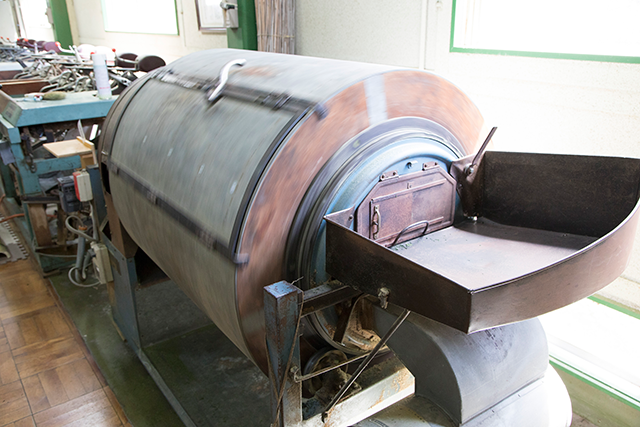
5.Shiagemomi (Final Rolling)
This includes the Denguri (pressing) and Itazuri (rubbing) steps in the Temomi Method.
This is an important step to shape the tea leaves.
The leaves are twisted and kneaded to take on the appearance of fine needles under a weight. The amount of weight to apply is quite sensitive, as too much will flatten the tea leaves, and too little will produce bent leaves.
This is an important step to shape the tea leaves.
The leaves are twisted and kneaded to take on the appearance of fine needles under a weight. The amount of weight to apply is quite sensitive, as too much will flatten the tea leaves, and too little will produce bent leaves.

6.Drying
Finally, the tea leaves are dried in a dryer. Too little drying will cause the tea to be discolored, badly preserved, or have a defective aroma. Too much drying will also discolor and deprive tea of its important flavor.
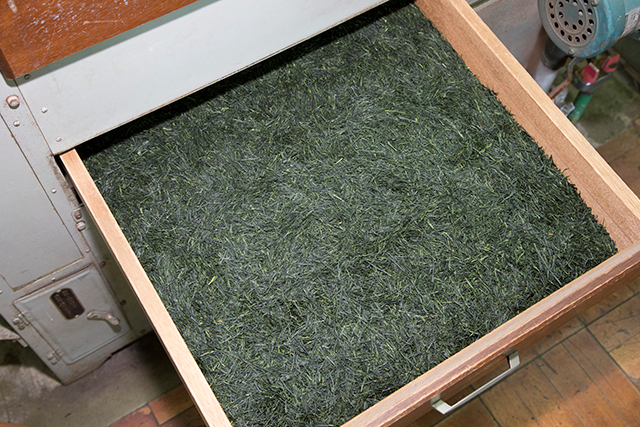
7.Final Step
The tea is sorted into leaves, stems and powder. After sorting, they are packaged to be sold as Gyokuro, Sencha, Karigane and Konacha.
Maiko Tea handles teas from plants grown under diligent attention and processed with exacting care. We blend Maiko teas according to decades of extensive experience gained in the tea market. It is our heartfelt desire to produce superior teas with fresh unique flavors that are available throughout the year, thereby serving our customers in the best way possible.
Maiko Tea handles teas from plants grown under diligent attention and processed with exacting care. We blend Maiko teas according to decades of extensive experience gained in the tea market. It is our heartfelt desire to produce superior teas with fresh unique flavors that are available throughout the year, thereby serving our customers in the best way possible.
